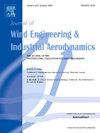Effect of building parameters on urban ventilation efficiency for pedestrian areas: Considering internal and external pollution sources
IF 4.9
2区 工程技术
Q1 ENGINEERING, CIVIL
Journal of Wind Engineering and Industrial Aerodynamics
Pub Date : 2025-06-13
DOI:10.1016/j.jweia.2025.106150
引用次数: 0
Abstract
This study investigated the impact of contemporary residential building layouts on urban ventilation efficiency through computational fluid dynamics simulations. Using a representative Shanghai residential district as a baseline model, multiple urban configurations were developed by systematically varying key parameters including building coverage ratio (BCR), passage width, building height distribution, and spatial arrangement while maintaining a constant floor area ratio. The analysis incorporated both internal and external pollution sources to assess pollutant dispersion patterns across different urban morphologies. Ventilation performance was evaluated using three dimensionless indices: spatially-averaged wind speed ratio, normalized concentration, and visitation frequency. Complementary analyses of air exchange rates and pollutant flux further elucidated ventilation mechanisms and interrelationships between evaluation indices. Main findings reveal that: enhanced ventilation correlates strongly with wider pedestrian passages and lower building coverage ratios; staggered building arrays demonstrate superior ventilation performance compared to aligned configurations under high-density conditions (BCR ≥0.166); vertical height variation in compact layouts (BCR = 0.33) improves ventilation efficiency by 8.8–22.1 % under perpendicular wind incidence (90°); compared to external pollution source, internal source show strong morphological sensitivity. This work validates the robustness of existing design parameter (passage ratio) in ventilation design and expands its scope of application for urban design and planning.
建筑参数对城市步行区通风效率的影响:考虑内外污染源
本研究通过计算流体力学模拟研究了当代住宅建筑布局对城市通风效率的影响。以具有代表性的上海住宅小区为基准模型,在保持恒定容积率的前提下,通过系统地改变建筑覆盖率(BCR)、通道宽度、建筑高度分布和空间布局等关键参数,开发出多种城市配置。该分析结合了内部和外部污染源,以评估污染物在不同城市形态中的扩散模式。采用空间平均风速比、归一化浓度和访问频率三个无维指标评价通风性能。空气交换率和污染物通量的补充分析进一步阐明了通风机制和评价指标之间的相互关系。主要研究结果表明:加强通风与更宽的行人通道和更低的建筑覆盖率密切相关;在高密度条件下,交错建筑阵列的通风性能优于排列结构(BCR≥0.166);垂直风向(90°)下,紧凑布局的垂直高度变化(BCR = 0.33)可使通风效率提高8.8 - 22.1%;与外部污染源相比,内部污染源表现出较强的形态敏感性。本研究验证了现有设计参数(通过率)在通风设计中的鲁棒性,并扩大了其在城市设计和规划中的应用范围。
本文章由计算机程序翻译,如有差异,请以英文原文为准。
求助全文
约1分钟内获得全文
求助全文
来源期刊
CiteScore
8.90
自引率
22.90%
发文量
306
审稿时长
4.4 months
期刊介绍:
The objective of the journal is to provide a means for the publication and interchange of information, on an international basis, on all those aspects of wind engineering that are included in the activities of the International Association for Wind Engineering http://www.iawe.org/. These are: social and economic impact of wind effects; wind characteristics and structure, local wind environments, wind loads and structural response, diffusion, pollutant dispersion and matter transport, wind effects on building heat loss and ventilation, wind effects on transport systems, aerodynamic aspects of wind energy generation, and codification of wind effects.
Papers on these subjects describing full-scale measurements, wind-tunnel simulation studies, computational or theoretical methods are published, as well as papers dealing with the development of techniques and apparatus for wind engineering experiments.

 求助内容:
求助内容: 应助结果提醒方式:
应助结果提醒方式:


